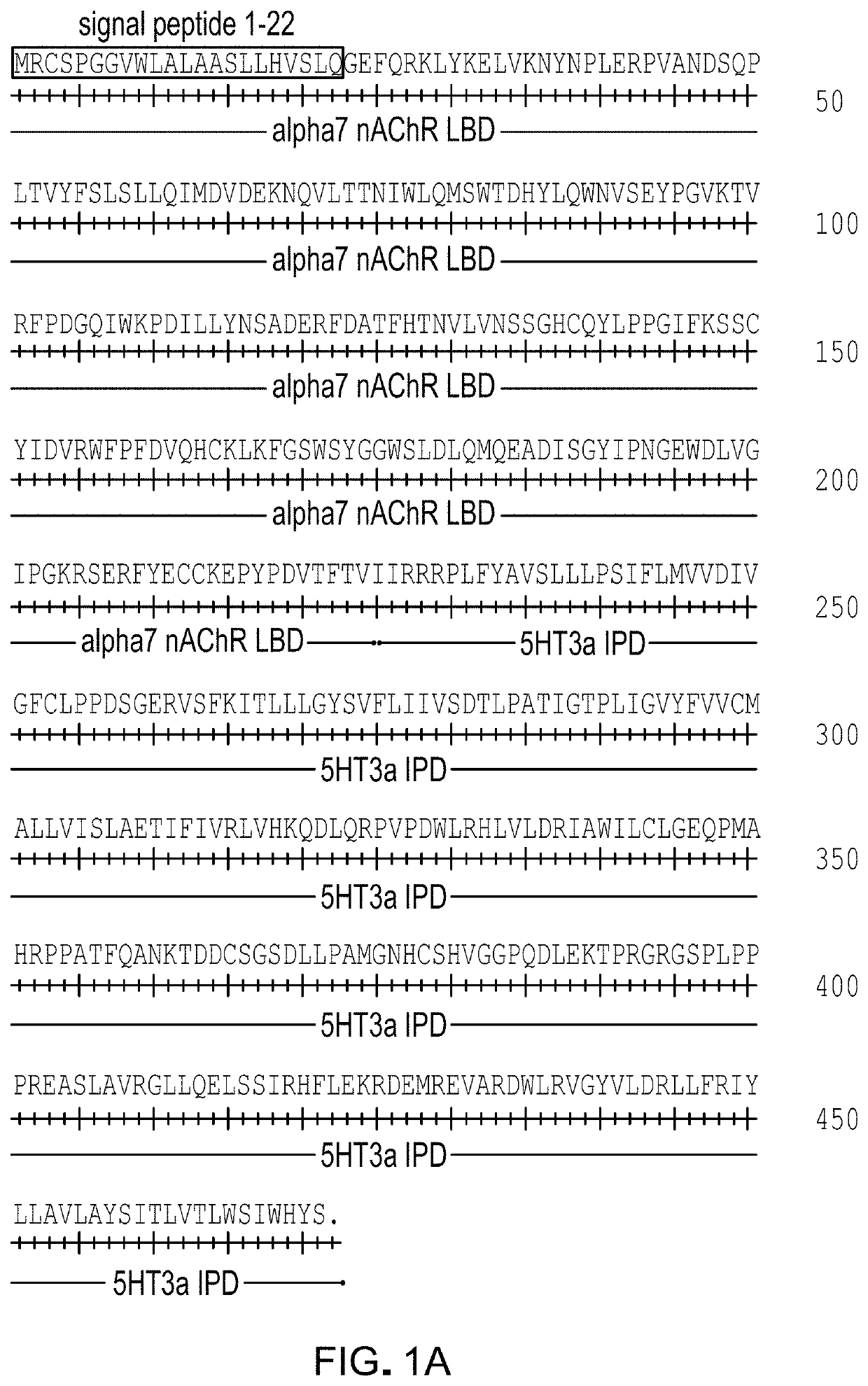Modified ligand-gated ion channels and methods of use
a technology of ligand-gated ion channels and modified ligands, which is applied in the direction of genetic material ingredients, viruses/bacteriophages, peptides/proteins, etc., can solve the problems of inability to easily control the levels of endogenous lgic ligands such as ach, and profoundly affect their biological function
- Summary
- Abstract
- Description
- Claims
- Application Information
AI Technical Summary
Benefits of technology
Problems solved by technology
Method used
Image
Examples
example 1
nhancing Ligand Binding Domain Mutations
[0181]A screen was performed with a panel of 41 α7-5HT3 chimeric channels having mutant LBDs against a panel of 51 clinically used drugs with chemical similarity to nicotinic receptor agonists. Mutations were at residues highlighted in FIG. 1. The screen revealed mutations at Gln79 in the α7 nAChR LBD that enhanced potency for the known nAChR agonist tropisetron (FIG. 2). These mutations (Q79A, Q79G, Q79S) reduce the size of the amino acid side chain. Some mutant ion channel-ligand combinations gave up to 12-fold improvement in potency (Table 1, FIG. 3). Canonical α7 nAChR agonists, ACh, nicotine, epibatidine, and the anti-smoking drug varenicline were not significantly affected by Q79A, Q79G, or Q79S mutations. However, a subset of α7 nAChR agonists showed enhanced potency with some of the mutations. Cytisine, RS56812, tropisetron, nortropisetron, and PNU-282987 showed significantly improved potency for α7Q79G-5HT3. Additionally, nortropisetr...
example 2
nhancing Ion Pore Domain Mutations
[0186]α7-GlyR channels having IPD mutations previously established in full length glycine receptor channels (T258S and A288G, GlyR numbering; equivalent to T268S and A298G for α7-GlyR numbering) were examined for enhanced potency for the allosteric agonist ivermectin. Channels having α7-GlyRT268S were found to have substantial ligand-free open probability, which rendered them unsuitable for ligand-controlled manipulations of cells. Mutations at α7-GlyRA298G, which were effective for enhancing ivermectin potency at the full length glycine receptor, led to modest change in open probability in the absence of the ligand; thus this channel was examined for activity against a panel of known agonists. For canonical agonists ACh, nicotine, and epibatidine, as well as for varenicline and tropisetron, the agonist potency was not significantly enhanced in α7-GlyRA298G. A subset of α7 nAChR agonists did show up to a modest 4-fold increase in potency: RS56812, c...
example 3
Exhibiting Enhanced Potency
[0190]Based on the structure activity relationship of known agonists that showed enhanced potency with α7Q79G-GlyRA298G, a variety of synthetic molecules comprised of either quinuclidine, tropane, or 9-azabicyclo[3.3.1]nonane pharmacophores with one or more aromatic side chain substituents were tested. In addition, the known α7 nAChR agonist PHA-543613 (Walker et al 2006, Wishka et al 2006) was also tested and showed exceptional potency for α7Q79G-GlyRA298G. These molecules generally showed enhanced potency 10-fold to 100-fold (Table 3), indicating that, for these pharmacophores, a range of structural features were compatible with improved potency for α7Q79G-GlyRA298G.
[0191]These results show that modified LGICs can be activated by synthetic quinuclidine-containing and tropane-containing LGIC ligands.
[0192]
TABLE 3Potency of compounds against chimeric channels. Mean EC50 and SEM in parentheses (μM) for agonist activity in HEK cellsexpressing chimeric channe...
PUM
| Property | Measurement | Unit |
|---|---|---|
| ionic flux | aaaaa | aaaaa |
| specific ion conductance properties | aaaaa | aaaaa |
| conductances | aaaaa | aaaaa |
Abstract
Description
Claims
Application Information
 Login to View More
Login to View More - R&D
- Intellectual Property
- Life Sciences
- Materials
- Tech Scout
- Unparalleled Data Quality
- Higher Quality Content
- 60% Fewer Hallucinations
Browse by: Latest US Patents, China's latest patents, Technical Efficacy Thesaurus, Application Domain, Technology Topic, Popular Technical Reports.
© 2025 PatSnap. All rights reserved.Legal|Privacy policy|Modern Slavery Act Transparency Statement|Sitemap|About US| Contact US: help@patsnap.com



